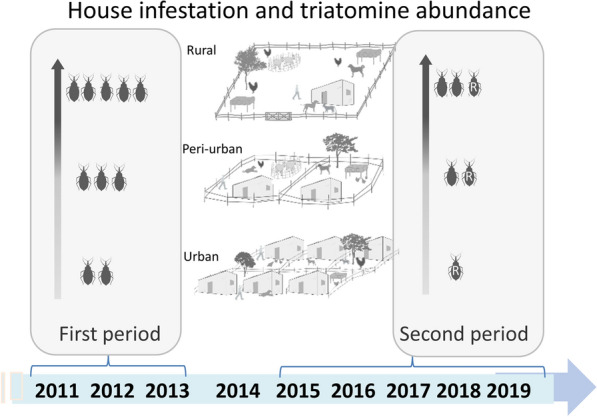- Record: found
- Abstract: found
- Article: found
Improved vector control of Triatoma infestans limited by emerging pyrethroid resistance across an urban-to-rural gradient in the Argentine Chaco

Read this article at
Abstract
Background
The sustainable elimination of Triatoma infestans in the Gran Chaco region represents an enduring challenge. Following the limited effects of a routine pyrethroid insecticide spraying campaign conducted over 2011–2013 (first period) in Avia Terai, an endemic municipality with approximately 2300 houses, we implemented a rapid-impact intervention package to suppress house infestation across the urban-to-rural gradient over 2015–2019 (second period). Here, we assess their impacts and whether persisting infestations were associated with pyrethroid resistance.
Methods
The 2011–2013 campaign achieved a limited detection and spray coverage across settings (< 68%), more so during the surveillance phase. Following community mobilization and school-based interventions, the 2015–2019 program assessed baseline house infestation using a stratified sampling strategy; sprayed all rural houses with suspension concentrate beta-cypermethrin, and selectively sprayed infested and adjacent houses in urban and peri-urban settings; and monitored house infestation and performed selective treatments over the follow-up.
Results
Over the first period, house infestation returned to pre-intervention levels within 3–4 years. The adjusted relative odds of house infestation between 2011–2013 and 2015–2016 differed very little (adj. OR: 1.17, 95% CI 0.91–1.51). Over the second period, infestation decreased significantly between 0 and 1 year post-spraying (YPS) (adj. OR: 0.36, 95% CI 0.28–0.46), with heterogeneous effects across the gradient. Mean bug abundance also dropped between 0 and 1 YPS and thereafter remained stable in rural and peri-urban areas. Using multiple regression models, house infestation and bug abundance at 1 YPS were 3–4 times higher if the house had been infested before treatment, or was scored as high-risk or non-participating. No low-risk house was ever infested. Persistent foci over two successive surveys increased from 30.0 to 59.3% across the gradient. Infestation was more concentrated in peridomestic rather than domestic habitats. Discriminating-dose bioassays showed incipient or moderate pyrethroid resistance in 7% of 28 triatomine populations collected over 2015–2016 and in 83% of 52 post-spraying populations.
Conclusions
The intervention package was substantially more effective than the routine insecticide spraying campaign, though the effects were lower than predicted due to unexpected incipient or moderate pyrethroid resistance. Increased awareness and diagnosis of vector control failures in the Gran Chaco, including appropriate remedial actions, are greatly needed.
Related collections
Most cited references61
- Record: found
- Abstract: not found
- Article: not found
Rings, circles, and null-models for point pattern analysis in ecology
- Record: found
- Abstract: found
- Article: not found
Chagas disease: a Latin American health problem becoming a world health problem.
- Record: found
- Abstract: found
- Article: not found
